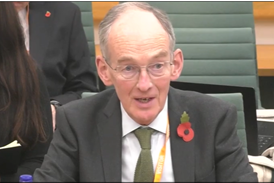Following the death of acclaimed criminal lawyer Arthur Prothero, James Morton takes a look at the cases he defended and his dealings with the infamous detective Bert Hannam
Lawyers who practised in the magistrates’ courts around London a few years ago will be sorry to hear of the death of Arthur Prothero, who died earlier this year – a few weeks short of his hundredth birthday. He was one of those lawyers whom a young solicitor could seek out and ask for advice as to how the bench or the stipe was likely to react to a particular line of defence. He would give his time and advice generously and genially.
Prothero’s name has gone into the law books as the solicitor in the celebrated DPP v Smith [1961] AC 290, but his most controversial defence was that of Alfred Whiteway, the Towpath murderer. This was a 1953 case that threw up all sorts of problems, particularly over the recording of interviews. It pitted the celebrated murder squad detective Bert Hannam against the barrister Peter Rawlinson, instructed by Prothero for Whiteway.
There is little doubt that Whiteway was guilty of the murder of two young girls, but the prosecution was in something of a mess. For a start, the murder weapon disappeared. Much of the case relied on the so-called confession by Whiteway to Hannam. The latter was said to have a photographic memory; and Nipper Read, the man who finally caught the Krays, recalls that Hannam had ‘an ability, in one sentence, to create a situation which made things very sinister and totally detrimental to the defence’.
A 16-year-old, Barbara Songhurst, was stabbed to death on the towpath at Teddington at the end of May 1953. She had gone cycling with a friend Christine Reed, whose body was found a week later. A witness said he recalled seeing a man riding a woman’s bike on the night of the girl’s disappearance, but although Hannam had the Thames dammed in the vicinity he could not find it. Then Whiteway was arrested for rape and an axe was found in his car. It promptly disappeared. It turned out it had been taken home by a constable who used it to chop wood. It was a month before he handed it in.
The challenged confession taken by Hannam included damning comments such as, ‘It’s all up. You know bloody well I done it, eh! I’m mental’. Rawlinson put Hannam through a gruelling two-day cross-examination on the methods he adopted in drawing-up the signed confession. He opened substantial gaps in the officer’s evidence and Hannam never forgot the experience. It was, said Rawlinson, ‘a completely manufactured piece of fiction written by the officer’. It was not that he was lying, suggested Rawlinson delicately, it was the juggling of context, a clever manipulation. The judge, Mr Justice Hilberry, as was natural at the time, would have none of it, and neither did the jury – Whiteway was convicted and hanged in short order.
Following the trial, there was something of an outcry that a police officer should have been subjected to such a cross-examination with a suggestion that he was being accused of ‘perjury with intent to murder’.
It was a time when the police went through the farce of producing notebooks made up identically down to the last comma, and, in the teeth of the evidence, stood their ground denying there had been any collaboration with other officers. And, however much they were made to look at best foolish and at worst liars, time and time again magistrates and judges supported them. Had those worthies taken a more realistic approach in the 1950s, the troubles of the Flying Squad, the Porn Squad and the Vice Squad in the 1970s and 1980s might never have occurred.
Detective Hannam had incurred the enmity of Percy Hoskins of the Daily Express, and when the officer arrested Dr Bodkin Adams for the murder of a number of patients in Eastbourne, the Express was the only paper in Fleet Street to champion Adams’ cause. Lord Beaverbrook, the then proprietor, told Hoskins he’d better be right and when the jury found Adams not guilty Hoskins sent his employer a telegram: ‘Two were acquitted’. Adams was fortunate that he had as the judge Patrick Devlin who took what could be called a more robust view of the detective. Later Devlin wrote that Hannam had proved an adept manipulator of the press ‘apparently for his own glorification rather than for any assistance which it could give to the investigation’.
Rawlinson went on to be a short-lived Attorney-General and the writer of a few legal thrillers. Prothero went on to defend countless others accused of murder, including Jim Smith, convicted of killing a police officer in March 1960.
An officer had stopped Smith as he was carrying stolen scaffolding clips in his van. He tried to accelerate away but the policeman clung to the bonnet only to be shaken off and to die later of his injuries. Smith claimed that he had only been trying to dislodge the officer.
The House of Lords held that what a man accused of murder intended was irrelevant to his guilt or innocence, a decision that provoked years of debate. However, Smith himself was reprieved.
James Morton is a former criminal law specialist solicitor and now a freelance journalist
Charity Explorer provides a reputable reference tool for solicitors, will-writers and their clients who want to leave a legacy or charitable gift.
Visit Charity Explorer
Whether you are looking for legal expert witnesses, legal training/CPD providers, international law firms, administration of estates, legal software suppliers, barristers chambers or any other general legal service, the Legal Services Directory will provide a suitable option.
Visit Legal Services Directory

























No comments yet